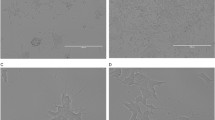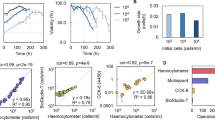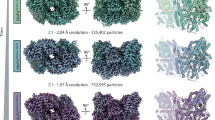Abstract
A COMMUNICATION on the morphological conversion of cells in vitro by N-nitrosomethylurea by Sanders and Burford1 prompts me to report similar experiments performed about 5 years ago in which the related and very effective carcinogen, N-methyl-N-nitrosourethane (MNU)2 was used. Its action in vitro was tested on various mammalian cells grown in tissue culture. These included the Syrian hamster fibroblast BHK 21/13 C cell line3 made available by Professor M. Stoker, and also fresh cultures of trypsinized baby (or foetal) rat heart fibroblasts. The cultures were maintained in Roux bottles, in Eagle's medium (containing double concentration of amino-acids and vitamins) and Hanks tryptose phosphate broth with 10 per cent calf serum. The cultures were trypsinized and sub-cultured once a week or more often. Explants, 24 h or 48 h old, were used for treatment with MNU of concentrations 1 × 10−2 – 1 × 10−5 molar. For this purpose, the medium was removed from the cultures and replaced by MNU dissolved in ethanol (1 : 10 v/v) and diluted to the desired concentration with phosphate buffer. After 30 or 60 min at 37° C, the MNU solution was decanted, the cultures were washed once with phosphate buffer, and left in fresh medium at 37° C.
Similar content being viewed by others
Article PDF
References
Sanders, F. K., and Burford, B. O., Nature, 213, 1171 (1967).
Schoental, R., Nature, 188, 420 (1960); 199, 190 (1963).
Stoker, M., and Macpherson, I., Nature, 203, 1355 (1964).
Ord, M. J., Nature, 206, 413 (1965).
Thomas, J. A., Delain, E., and Hollande, E., CR Acad. Sci., 264, 785 (1967).
Author information
Authors and Affiliations
Rights and permissions
About this article
Cite this article
SCHOENTAL, R. Effects of N-Methyl-N-nitrosourethane on Cells in Tissue Culture. Nature 215, 535 (1967). https://doi.org/10.1038/215535a0
Received:
Revised:
Published:
Issue date:
DOI: https://doi.org/10.1038/215535a0
This article is cited by
-
In vitro Transformation of Syrian Hamster Embryo Cells by Diverse Chemical Carcinogens
Nature (1972)
-
Action of nitrosomethylurea and dimethylnitrosamine in organ cultures of mouse embryonic lungs
Bulletin of Experimental Biology and Medicine (1971)



